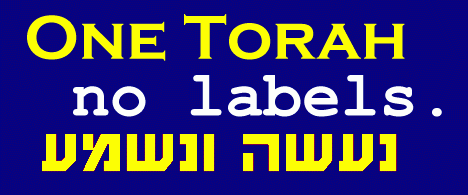or, There and Back Again Without Leaving
(BECAUSE OF WORDPRESS, I’M REPUBLISHING this 2002 piece — it works better as a “post” than as a “page” — and although my kippa-wearing has become a bit less pronounced of late it still reflects my approach to finding a place in Judaism. If you’re not hot for apologetics or manifesti, you have my permission to read something else.)
Despite that I’ve worn a yarmulke most of the time since 2000, I don’t define myself as Orthodox. Or Reform. Or, for that matter, as Conservative, Reconstructionist, Renewal or otherwise adjectivally Jewish.
I’m just a reg’lar ol’ Jew who’s intensely curious about all forms ‘n’ norms of Jewish practice and wants to experience them from the inside. Those who live Torah because they believe it’s something God (or G-d, or Gd, or [my fave] G?d) wants should live and be well. I’m not smart enough to know what God wants, so my Torah is an ongoing answer to the question: “How did this hang together for so many thousands of years?” To paraphrase Rabbi Mordechai Kaplan, I don’t want my Judaism to be a funeral for my parent’s religion.
I was initially nervous about adopting the kippah, although most people seem neither to care nor to notice. But wearing a yarmulke in public is like having a Jewish lighthouse on my head, and has led to numberless interesting encounters (and so far, only one real hassle). I’ve discussed Torah with an Aramaic-speaking Iraqi Christian who runs the local 7-11, compared halal to kashrut with an Arab fellow-patron of my favorite bakery, and reassured a nervous professed Catholic that, although the wind hasn’t yet removed it, a nest-building blackbird once almost did.
Then there’s the Jewish response.
Mostly it’s one of a dozen variations on “Go Team!” But there’s a small subset who seem to think it “a little too Jewish.” I’ve had people apologize to me for their perceived lack of observance, browbeat me for “making the rest of us look bad,” or argue that tefillin today means Ghawdknowswhat tomorrow. One guy even chided me for believing in medievalist blather. (To be fair, I like medievalist blather — as well as all types of folklore, astronomy, geology, archaeology, anthropology, science fiction and fantasy.)
It’s just plain weird sometimes. But, fortunately or unfortunately, I don’t seem to be alone.
Like many Jews of my age and experience, I abandoned my natal faith shortly after Bar Mitzvah in 1975. I was thoroughly convinced (as only a 13-year-old can be) that childish stories and intricate rule-sets were incompatible with a quest for Higher Truth, and through the next 22 years I wandered every path I could find: Zen, Wicca, Magick, Gnosticism and a dozen points in-between and beyond. All were beautiful, each taught me something useful, but none scratched my deepest and most primal curiosity-itch. (I was actually expelled from one informal Berkeley coven for my innocent but ceaseless questioning of their basic assumptions. Evidently, the right brain wasn’t supposed to know what the left was doing).
Thus, it was with a sort of painful comfort that I found myself re-embracing Judaism at 35, and realizing that, as with any time-fortified mythic structure, one doesn’t need to take it literally in order to take it seriously. I dug past the superficialities I had been raised with, and the more I dug the more I found to dig. And I’m still digging.
Many Jews I know want a Judaism that challenges us to live ethical lives, keeps us pointed to the Omnipresent Center, and offers a place in an ages-old chorus sung by people we know but have never met. And so, without fanfare or the yichus/baggage of a “movement,” we are rediscovering the ancient forms and making them fit like long-disused but hemmable garments.
“Isn’t it scary, trying on all this old stuff?” someone asks. “Won’t it look goofy?”
“These are our clothes,” someone else answers. “They belonged to our ancestors, and together, we’ll make a good fit for ourselves — even if we disagree about what they should look like. After all, disagreement is part of the process — questioning the tradition is the tradition — and besides, don’t we want our kids to wear them?”
Bottom line: “I don’t give a rip about how other people ‘do Jewish.’ What I give a rip about is having someone else to ‘do Jewish’ with.” Am Yirael chai — the Jews, they yet live — l’chaim!
Or, More Succinctly:

One Torah.
Last I checked, all the denominational flavors study the same text and pray the same formula first laid down 2,500 years ago. Only the interpretive assumptions (and seating/dining arrangements) differ. And isn’t that just like life in general?
No labels.
If you start with Torah, you get wholeness. If you start with “Reform,” “Conservative,” Orthodoxy,” et al, you get splinters. Splinters fester.
Na’aseh v’nishma.
What the Israelites told Moses after he offered them Torah (Exodus 24:7): “We’ll do and we’ll understand.” From a Western perspective, this sounds backwards. But from a practical perspective, it’s how we learn.
By Neal Ross Attinson
(See also Posse Commentatus for a view of Torah as fanac. For more on Jews and Judaism, see “Midrash Nachum”; for the religious life as lived, see the articles tagged “Being, Jewishly” and/or “There’s A God In My Soup”; for why I’m not a rabbi (something I once studied for), see “Why I’m Not A Rabbi.”)

I’m not Jewish, nor much of a scholar of the ‘old testament’, so much of this is a mystery to me. i do feel really comfortable with the desire to question and question again. And I think that splinters are counter-productive when unity is what gets the work done.